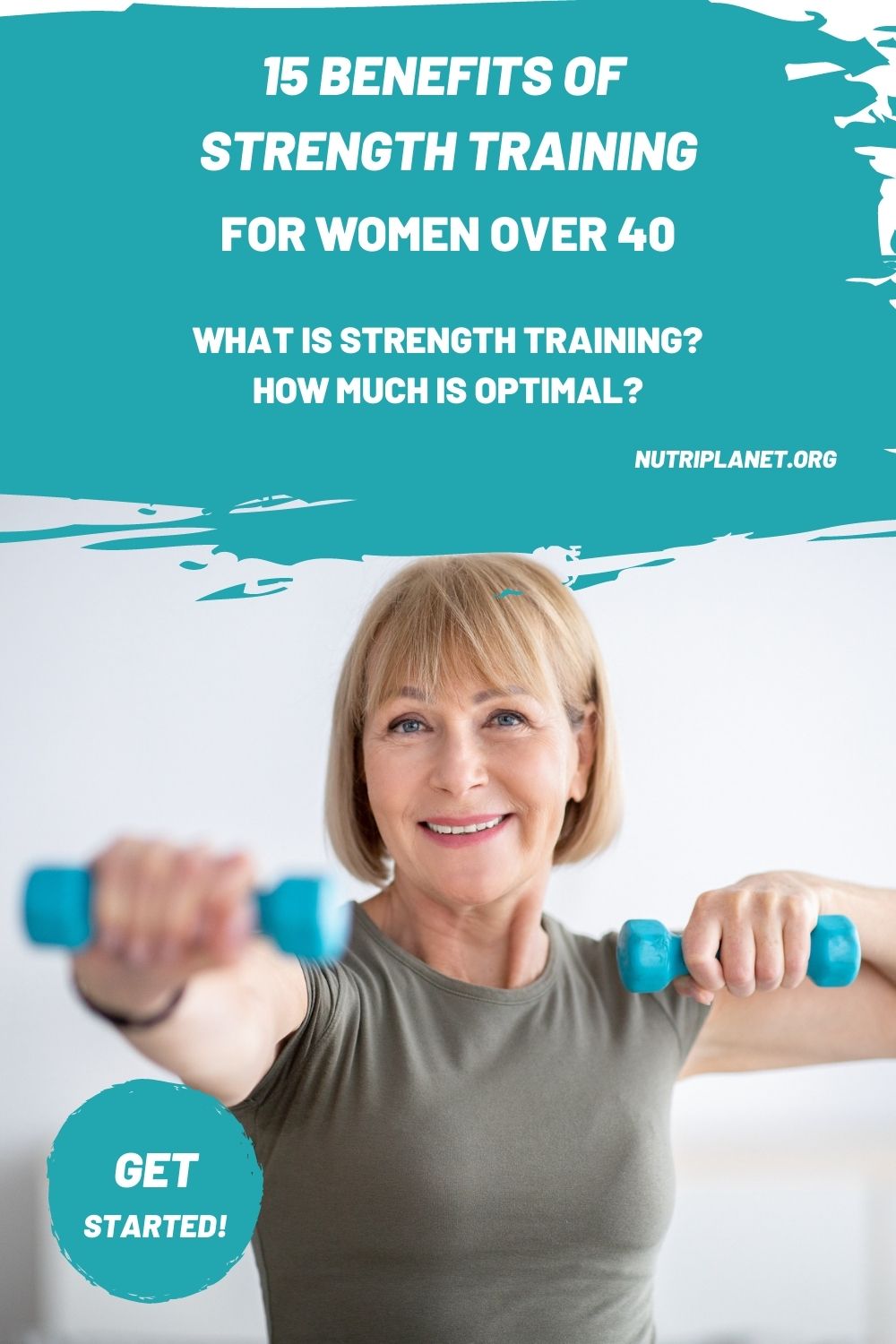Learn what is strength training and what are the main benefits of strength training for women over 40 years old i.e., for peri-menopausal, menopausal, and post-menopausal women.
However, before diving into the benefits, let’s clarify what strength training is.
Table of contents
- What is Strength Training?
- 15 Benefits of Strength Training for Women Over 40
- Prevent Muscle Loss
- Increase Metabolism
- Better Hormonal Balance
- Strength Training for Women Boosts Libido
- Fat Loss and Reduction of Abdominal Fat
- Bone Health
- Strength Training for Women Makes You Stonger
- Better Blood Sugar Levels
- Mitochondrial Health
- Better Mood and Brain Health
- Anti-Ageing Effects of Strength Training for Women
- Greater Mobility and Flexibility
- Improve Sleep and Decrease Stress
- Improve Posture
- Better Quality of Life
- How to Begin with Strength Training for Women?
What is Strength Training?
Strength training, resistance training, weight training, or muscular training involves the performance of physical exercises which are designed to improve strength and endurance.
The general definition of strength training is any physical movement in which you use your body weight or equipment (e.g., dumbbells and resistance bands) to build muscle mass, strength, and endurance. [1, 2]
Other ways to use resistance include body weight training, tubing, bands, and even use of water exercise. The key is finding a way to strength train that enables you to safely do more pulling exercises than pushing exercises. It’s beneficial to reach fatigue with the major muscles of the lower body.
For example, let’s compare a Pilates session to a session using dumbbells resulting in muscular fatigue in each set. The muscle strength, bone health, and metabolism benefits of the strength training surpass that of Pilates exercise.
Sign up for free for “5 Day Flip”!
You’ll get 5 short workout videos no more than 15 minutes each.
Yet you’ll do strength training, cardio and even a core/recovery day.
PLUS, get a short audio daily that helps you connect your hormones to your exercise.
Designed by international fitness expert Debra Atkinson.
In just 5 days you will:
Learn the right exercise for YOUR body.
Be on your way to a stronger core.
Identify exercise that makes you feel better (not tired).
Activate your natural fat burning capabilities.
Be more resilient to stress.
Start sleeping better.
Sign up for free for “5 Day Flip”!
15 Benefits of Strength Training for Women Over 40
Now, let’s dive into the main benefits of strength training for women… and men for that matter.
Prevent Muscle Loss
Muscle mass peaks at age 25. The loss of muscle for adults who aren’t resistance training is between 8 and 10% every decade. At that rate, living longer will result in sarcopenia (significant muscle and strength losses) in latter decades.
The Damage Muscle Loss Does
For your information, muscle is metabolically active. In fact, some studies say it requires 35 calories to maintain a pound of muscle and only 2 to maintain a pound of fat. Yet, most of us will eat the same no matter what our weight is. See the problem? That 33 calories per pound of muscle difference every day all year can help you with what should never have been accepted as “middle-age weight gain.”
By the way, we can also call it middle-age inactivity, or middle-age-inappropriate activity. You can’t sweat your way out of this by doing aerobic exercises. The same goes for randomly lifting weights at the end of your fitness class. In other words, you can’t strength train on the whim of a fitness instructor’s decision the day you drop into a class. Instead, you need a strength training plan.
The truth is, the best plan would have been a progressive strength training plan begun in your 30s and 40s to prevent losses. It’s because muscle loss begins at 30 if you’re not lifting.
Next best thing? Start strength training for women now, because muscle mass can be developed at any age, even beyond 80 and 90 years of age.
Increase Metabolism
Moving on, loss of muscle mass and a correlating increase in body fat reduces metabolism. When you do it correctly, strength training will result in fat loss. In addition, you’ll increase your metabolically active lean muscle that will positively effect metabolism both at rest and after exercise as you age. [3]
Better Hormonal Balance
Next, strength training for women will result in better hormonal balance. Human Growth Hormone (GH) influences metabolism, body composition and aerobic exercise capacity throughout life. However, GH production declines naturally with age. On the other hand, resistance training and intense interval training can boost GH significantly. [4]
Next, testosterone is supportive of libido and of self-confidence. As sex hormone levels decline for women in peri-menopause testosterone levels often dip. Again, intense resistance and interval training are the best ways to naturally boost testosterone levels. At the same time, endurance exercise reduces testosterone.
Strength Training for Women Boosts Libido
It’s known that forty to sixty percent of women in peri-menopause suffer from low libido. An informal survey at flippingfifty.com reveals an even greater percent of women in peri-menopause, menopause, and post-menopause who report low libido.
Libido can wane from multiple reasons including lack of body confidence, dropping testosterone levels, and low energy. Exercise, specifically strength training for women, counters each of those factors. [5]
Sign up for free for “5 Day Flip”!
You’ll get 5 short workout videos no more than 15 minutes each.
Yet you’ll do strength training, cardio and even a core/recovery day.
PLUS, get a short audio daily that helps you connect your hormones to your exercise.
Designed by international fitness expert Debra Atkinson.
In just 5 days you will:
Learn the right exercise for YOUR body.
Be on your way to a stronger core.
Identify exercise that makes you feel better (not tired).
Activate your natural fat burning capabilities.
Be more resilient to stress.
Start sleeping better.
Sign up for free for “5 Day Flip”!
Fat Loss and Reduction of Abdominal Fat
Do you want to know how NOT to gain weight, total fat, and belly fat with age? The answer is strength training.
Why should you care about belly fat anyway? Fat stored around the abdomen, especially visceral fat, is associated with an increased risk of chronic diseases, including heart disease, non-alcoholic fatty liver disease, type 2 diabetes, and certain types of cancer. [6, 7, 8, 9]
Following post-menopausal women for 6 years, those that had the greatest consistency with strength training, maintained weight, total and regional (belly) fat. Those with no resistance training gained significant weight, total and trunk fat over 6 years post menopause. [10]
The best ways to combat belly fat for menopausal women:
- Weekly workout schedule that includes strength training and interval training.
- Strength train to muscle fatigue in each set.
- Reach breathlessness in your interval training.
- Volume for strength training should come from the sets and repetitions not from the frequency of lifting. Increased lifting frequency reduces the recovery time and tends to decrease overall intensity.
- Prefer total body workout because split routines get 8 times fewer results.
Bone Health
Bone mass peaks close to age 30. At that time there’s minimal opportunity to enhance bone density. Loss of bone without resistance training occurs at a rate of anywhere from 0.5 to 3-5% in a year depending on a woman’s phase of life.
Nearly all older women living beyond 80 will experience osteoporosis which makes them susceptible to fracture related to falls. What’s more, small-framed women, or those with a high number of risk factors will have osteoporosis earlier in life.
Did you know that increasing bone density post menopause was once thought not possible? However, this may have been due to the very conservative nature of the strength training performed. At best, people were able to slow or halt their bone loss, and even that created a positive change. Imagine, losing 1-2% bone density a year, and then not losing any. That indeed is significant change.
Now, more recent studies that combine dietary changes with adequate weight training stimulus have been proven to increase bone density in post-menopausal women. [11]
However, the gap in research is clear. Some protocols do not work to increase or positively protect bone health. Work with an expert in osteoporosis, a Medical Exercise Specialist, or someone who has done the research and is willing to show it to you.
To sum it up, resistance training is the only exercise which prevents natural bone loss or reverses the loss even in menopausal or post-menopausal women. [12]
Good news is that you can reap the bone-strengthening benefits of strength training at any age.
Strength Training for Women Makes You Stonger
Strength training helps you become stronger. Furthermore, it lowers your risk of falls, as you’re better able to support your body. [13, 14, 15]
For example, one review including 23,407 adults over the age of 60 showed a 34% reduction in falls among those who participated in a well-rounded exercise program that included balance exercises and resistance and functional training. [15]
Furthermore, strength training can help correct your muscular imbalances. For example, having a stronger core, hamstrings, and glutes takes the load off your lower back during lifting, which in turn decreases your risk of lower-back injuries. [16, 17, 18]
Better Blood Sugar Levels
Muscles play a notable role in the regulation of blood sugar levels. In fact, with the help of insulin, the muscles can draw in glucose from the blood, lowering blood sugar levels. [19]
In addition to helping your body be more efficient at transporting insulin to your muscles, strength training also allows your muscles to absorb more glucose. That means that after you exercise, your muscles will continue to use glucose and your blood sugar may be lower for several hours. [20]
Compared to aerobic exercise, positive influence on blood sugar and insulin resistance occurs more predictably with strength training. [21]
Mitochondrial Health
Mitochondria are those powerhouses of energy that slow in production as a natural part of ageing. They are important for many tissues in the body and body function, not just muscle.
However, mitochondrial ageing can be reversed and or prevented with proper intensity exercise. Both high load and low load resistance training done to muscular fatigue are beneficial for mitochondrial health. [22]
Again, the solution is not a mild walk every day, but some vigorous and intense exercise, consisting of both resistance training and exercise to breathlessness.
Energy is generated in the mitochondria, once believed to naturally decline with age and accepted as a fact of life. In the last 8-10 years research has shown that mitochondrial function can be improved, and declines reversed. So, older adults have the same relative mitochondria function as young adults after regular strength training. [23]
Better Mood and Brain Health
Regular weight training may boost your mood and improve your mental health. It’s because exercise promotes the release of mood-boosting endorphins, which can play a role in a positive mood. [24, 25, 26]
Exercise has long been a mood booster for many. It’s also supportive of decreasing signs and symptoms of depression and anxiety, as well as increasing function of the hippocampus aka memory central. Resistance training along with cardiovascular training helps problem solving skills and creativity as well. [27]
Those who engage in strength training may have better brain health and protection against age-related cognitive decline.
Multiple studies in older adults have pointed to significant improvements in cognitive function (e.g., processing speed, memory, and executive function) after participating in strength training, compared with those who did not participate in it. [28, 29, 30]
Sign up for free for “5 Day Flip”!
You’ll get 5 short workout videos no more than 15 minutes each.
Yet you’ll do strength training, cardio and even a core/recovery day.
PLUS, get a short audio daily that helps you connect your hormones to your exercise.
Designed by international fitness expert Debra Atkinson.
In just 5 days you will:
Learn the right exercise for YOUR body.
Be on your way to a stronger core.
Identify exercise that makes you feel better (not tired).
Activate your natural fat burning capabilities.
Be more resilient to stress.
Start sleeping better.
Sign up for free for “5 Day Flip”!
Anti-Ageing Effects of Strength Training for Women
Your DNA influences the way you age, but not nearly as much as the lifestyle you follow. Six months of strength training slows down or reverses ageing and the expression of 179 genes associated with ageing. [31]
The same study found that just twice weekly strength training for 6 months positively influences the expression of 179 genes associated with ageing. [31] As a woman over 40, you want to know all about it!
This phenomenon of reversing ageing is also closely related to improvements in mitochondria function with ageing.
Age-related muscle losses are fibre specific. Fast Twitch (FT) muscle fibres are lost twice as fast as you age. Also, they are responsible for both metabolism and reaction skills. Your ability to right yourself if you trip to avoid falls or react quickly to changing terrain or body positions is related to the amount of FT fibre you have. [32]
Greater Mobility and Flexibility
Although it may come as a surprise to you, strength training can make you more flexible.
Flexibility is measured by joint range of motion (ROM). Those with weaker muscles tend to have lower ROM and flexibility. [33]
Furthermore, a recent review comparing stretching with strength training found they were equally effective at increasing ROM. [34]
For best results, you need to ensure you’re completing the full ROM of an exercise — in other words, utilise your full movement potential around a joint. For example, lower yourself into a squat as far as you’re able to go without compromising your form. [35, 36]
Improve Sleep and Decrease Stress
Did you know that it takes 10 minutes of exercise to positively improve self-ratings of sleep by 33%? That’s with no imposition of intensity or measurement of parameters. Moreover, long-term regular strength training brings about improvements in sleep. [37]
It’s noteworthy that the damaging effects of stress are related to over 80 diseases. By increasing resilience to stress both the physiological and psychological responses to it are lower. Moreover, blood pressure, anxiousness, adrenal responses, and ability to focus or remember, improve in fit individuals compared to sedentary.
It’s a fact that the incidence of depression is significantly higher in older women than men. The good news is that resistance training has proven to be instrumental in improving mild to moderate depression. [38]
Studies show that the positive impact of exercise is comparable to or better than medications or cognitive therapies. Most importantly, compared to medications exercise offers no negative side effects. [39]
Improve Posture
The effects of a life “out front” causes rounded shoulders, rounded upper back, and forward head hang, all worsened by cell phone use and “tech neck” today. Correct selection and performance of strength training exercises can help correct these incorrect postures and the ensuing depressive states that accompany them. [40]
Better Quality of Life
Finally, strength training may increase your quality of life, especially as you age. One review of 16 studies including adults ages 50 years and older showed a significant correlation between resistance training and better mental health, physical functioning, pain management, general health, and vitality. [41]
How to Begin with Strength Training for Women?
When you perform strength training, whether at a gym alone, with a personal trainer, or at home alone, there are virtually no negative and dozens (partial list above) of positive benefits.
- Start strength training after 40 or 50 with a solid foundation of basic movements (push, pull, squat and hinge exercises).
- Use sessions slightly higher in repetitions (15-20 or even up to 25 repetitions depending on your condition).
- Feel free to use dumbbells at home, or at the gym. You can use machine weights as well.
- You will need a bar or equipment of some kind to do pulling or hinging movement against resistance. However, you will be able to do strength training with just your own body weight as well.
Do You Need Support with Strength Training?
Think about it – is your exercise giving you energy or robbing you of energy? If you’re putting in the time and effort but not feeling more energetic, sleeping better, and enjoying life more, maybe it’s time to regroup.
When hormones change, exercise needs to change as well. You don’t need “chair aerobics” yet! But you may need a more hormone-balancing approach to exercise. It takes something different to stop muscle and bone losses after menopause.
My friend and international fitness expert, Debra Atkinson is the founder of Flipping50, home of the first and exclusively made for menopause fitness membership in the world. If you’re looking for a start, or a restart, she’s got one.
You can start her “5 Day Flip” today. The 5 short videos she’ll send are no more than 15 minutes each. Yet you’ll do strength training, cardio and even a core/recovery day. You’ll get a snapshot of how Debra plans (her own and her VIP clients’) workouts.
She also knows you’re not just hormones and your joints may need some TLC (tender loving care). So, you won’t find harsh, extreme exercise. She’s a stickler for cues that keep you doing moves correctly for best results.
Here’s where to get started today!
The video will land in your inbox in a few minutes! PLUS, you’ll get a short audio daily too that helps you connect your hormones to your exercise.
Disclosure: this post contains affiliate links. As a Flipping50 affiliate partner I earn from qualifying purchases. For every purchase made from the links in this post, you’ll be able to support my work. So you can look after your health, and contribute to my mission at the same time. Thank you!
Read more articles on exercise!
You’re welcome to PIN the below image!





































